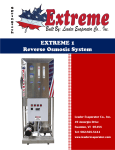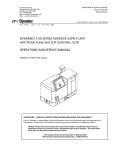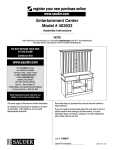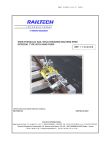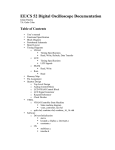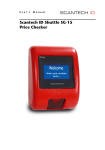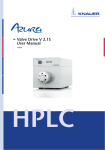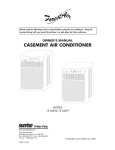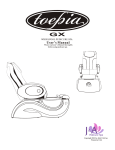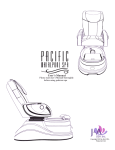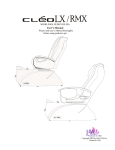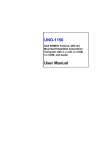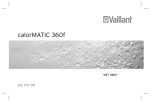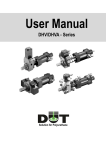Download LEADER EVAPORATOR LTD. 49 Jonergin Drive Swanton, Vermont
Transcript
OPERATOR’S MANUAL 80 GPH LEADER EVAPORATOR LTD. 49 Jonergin Drive Swanton, Vermont 05488 TEL. : (802) 868-5444 www.leaderevaporator.com VERSION 2005-02-02 TABLE OF CONTENTS 1.0 USER’S MODE FOR COMMERCIAL REVERSE OSMOSIS .......................................5 1.1 INTRODUCTION ........................................................................................5 1.2 HISTORY ................................................................................................5 1.3 FUNCTIONING .........................................................................................5 1.4 PARTS…………………………………………………………………………6 1.5 INSTALLATION.........................................................................................9 2.0 YEARLY START UP ...................................................................................... 10 3.0 USER GUIDE ............................................................................................... 11 3.1 CALCULUS OF % CONCENTRATION ........................................................12 3.2 MEMBRANE PERMEABILITY TEST ...........................................................13 3.3 ANNUAL CLOSING PROCEDURE..............................................................14 3.4 ANNUAL STORAGE WITH ANTIFREEZE .....................................................15 3.4.1 PRESERVATION SOLUTION..................................................................15 4.0 MANUFACTURE GUARANTIE ......................................................................... 16 5.0 EQUIPMENT DESCRIPTION ............................................................................ 17 5.1 PHYSICAL DIMENSIONNES .....................................................................18 5.2 OVERPRESSURE PUMP ..........................................................................19 5.3 MEMBRANE HOUSING ...........................................................................20 5.4 CONTROL PANNEL................................................................................21 5.5 PERFORMANCE LECTURE .....................................................................22 5.6 PRODUCTION SHEET FOR RO .................................................................26 5.7 CORRECTION FACTOR FOR MEMBRANES.................................................22 2 LISTE OF FIGURES Figure 1. OSMOSIS AND REVERSE OSMOSIS PROCEDURE ........................................ 4 FIGURE 2. PRIMING PUMP.......................................................................................6 FIGURE 3. RESERVOIR IN STAINLESS STEEL .............................................................6 FIGURE 4. THREE WAYS VALVE...............................................................................6 FIGURE 5. TEMPERATURE DIGITAL CONTROLLER......................................................6 FIGURE 6. FILTER AND HOUSING .............................................................................6 FIGURE 7. LOW PRESSURE SWITCH.......... ..............................................................7 FIGURE 8. PRESSURE GAUGE.… ............................................................................7 FIGURE 9 MEMBRANE & PRESSURE PUMP……...... ..................................................7 FIGURE 10 CONTROL BOX..........… ........................................................................9 FIGURE 11 PICTOGRAM....……….........................................................................11 FIGURE 12. DATA RESULTS..................................................................................12 FIGURE 13. ILLUSTRATIVE UNIT MODEL .................................................................18 FIGURE 14 OVERPRESSURE PUMP......... ...............................................................19 FIGURE 15 MEMBRANE HOUSING......... .................................................................20 FIGURE 16. FRONT PANNEL .................................................................................21 FIGURE 17. PERFORMANCE UNIT TABLE ................................................................22 FIGURE 18. PRODUCTION PAGE FOR REVERSE OSMOSIS ........................................25 FIGURE 19. CORRECTION FACTOR... .....................................................................27 3 Figure 1. Osmosis and Reverse Osmosis 4 1.0 USER’S MODE FOR COMMERCIAL REVERSE OSMOSIS CONGRATULATIONS! You just acquired an LEADER EVAPORATOR reverse osmosis. This proves your interest in new technologies and beautiful things. In fact, you have purchased a technologically advanced unit built by skilled professionals at A. Pellerin & Fils Ltée, who bring many years of research to the use of reverse osmosis in maple syrup production.. 1.1 INTRODUCTION : Reverse osmosis is a process by which a solution’s natural tendency to scatter its components uniformly is reversed. It occurs in the reverse osmosis because an applied pressure forces the water through a semi-permeable membrane. The water that does not pass through the membrane is left with all the sugar and thus called the concentrate. 1.2 HISTORY : The procedure of reverse osmosis was observed and studied since more than 200 years. Abbé Nolet a French scientist had experimented the basic phenomena around 1748. The scientists had figure out after long time, that the natural process could be reversed and many applications could be dispose of in their research. This principle is applied to the process of water desalination since the beginning of the 60’s. 1.3 FUNCTIONING : How this unit works? This is probably the first question that came to your mind as you opened this manual. The sap provided by maple trees is a solution containing mostly water (96% to 98%), 2% to 3% sugar and small quantities of mineral salts, proteins and other elements such as aroma. Sap is the solution in which you will increase the amount of sugar in relation to the quantity of water. This will be done by extracting the water from the maple tree sap. This separation process will give a more concentrated sap solution (concentrate) and the portion of water which has been subtracted from the sap (permeate). 5 1.4 PARTS : Priming pump and Reservoir All liquid amount inlet that is in the your unit is pumped by the priming pump, whatever, the maple sap that is coming from your reservoir’s or the washing solution that is founded in the washing reservoir in stainless steel (CIP) located at one side of the unit. Figure 2. Priming pump Figure 3. Reservoir (SS) Three ways valve The feeding process is effectuated by the three ways valve (V6) located at the input of the unit. Figure 4. Three ways valve (V6) Digital Temperature Display This controller evaluates the liquid’s temperature as it penetrates the reverse osmosis. The value is immediately displayed on a screen located on the reading panel. The temperature must never exceed 49o Celsius (120o Fahrenheit). The programming manual is available inside the reading panel. It works at 50/60Hz, AC100-240, 6.6 VA. Figure 5. Temperature digital display Pre Filter: The sap is filtered by a 10 micron cartridge. This clears it from any substance in suspension. The sump and cap are made of a polypropylene material and the cap includes a Pressure relief valve. Flow rates from 1gpm to 15gpm. Max Pressure: 100psi(6.9 bar). Max Temperature: 100F (37.7C). Figure 6. Filter and housing 6 Low pressure control This control ensures that the filters are not obstructed by dirt or micro-organisms. If such were the case, the machine would stop by itself, thus protecting the pumps and membranes Figure 7. Low pressure Switch Pressure Gauge If this is the case, the machine (RO) will stop by itself protecting the pump(s) and the membrane(s). A pressure gauge will allows you to visualize the filter output pressure at the control panel, if the pressure is lower than 12 pds./inch2 the unit will stop by itself. Figure 8. Pressure gauge Membrane and Pressure pump The filtered water is pressurized with the help of the pressure pump. The lower part of the pump creates what is called recirculation. This gives the sap the necessary speed to clean the membrane surface M5 automatically during the sap concentration process. The same thing happens to the washing liquid during the soap and recirculation washes. The sap is concentrated by the membranes resulting in a sweeter sap (concentrate) and treated water (permeate). It is possible to add more membranes just to increase your reverse osmosis capacity. Membrane Pressure pump Figure 9. Membrane and pressure pump V2 : Concentrate flow regulating valve As it comes out of the membrane, the concentrate sets out for the reading panel, reaching a flow regulating valve. The flow will be measured by a flowmeter. You can adjust the concentration percentage by regulating the concentrate flow. The sample valve will allow you to determine the concentration that suits you. Concentrate flowmeter This flowmeter calculates the concentrate flow. The value, in gallons per minute (GPM), is indicated on the reading panel 7 Permeate flowmeter As it comes out of the membrane, the permeate is run directly through this flowmeter. The flow value is indicated on the reading panel in GPM. During the concentration process, the liquid is directed to the permeate storage basin. It is essential to know the permeate and concentrate flows to calculate the sap concentration percentage. This calculation is detailed in section 3.1 CALCULATION OF THE SAP CONCENTRATION %. V1 : Concentrate pressure regulating valve This valve controls the concentrate pressure. The pressure increases as you tighten the valve and decreases as you loosen it. Pressure gauge (membrane pressure) It is this gauge which evaluates the concentrate pressure in the membrane. It is possible for you to know the value of this pressure (in psi.) simply by looking on the reading panel. Permeate sample valve This valve is located at the top of the permeate V3 valve. You can know if the reverse osmosis process is performed correctly by analyzing the permeate. For example, if the membrane is damaged and therefore not able to retain all the sugar, your permeate will be sweet. Concentrate sample valve Located at the top of the V4 valve, this valve allows you to obtain a concentrate sample before it is sent into the concentrate basin. With this sample you will be able to note the difference made by a change of the concentrate flow on the concentration percentage and therefore you will be able to obtain the sweetness you want. Concentrate basin After going through the valves, flowmeters and gauges, the concentrate is directed to a storage basin (concentrate basin) to feed the evaporator. The company does not provide you with this basin. V3 : Permeate direction valve V4 : Concentrate direction valve The direction taken by the liquid is determined by the three-way valve position. The black arrows indicate which ways the permeate (V3) and the concentrate (V4) can go. V19 : Direction valve This valve directs the water during washing or rinsing only. 8 Control Box The unit control is done by the an electric control box, inside this box all the electrical components are included, such as : contacts, timer relay, the temperature control, the positional switches, the fuses, etc.) Figure 10. Control Box 1.5 INSTALLATION : All the concentrators of ‘’A. PELLERIN et FILS’’ are delivery with a three way valve at the input of the unit. You must provide the couplings for your basin in a way of avoiding a restriction at the time of rising your unit, the waterproofness of the source feeding must be verified in order to avoid the creation of vibrations that will cause a deterioration of the pressure pump and the membrane. The maple sap is therefore conducted by the source feeding pump from the basin just to the unit. It is recommended to connect the filtrate basin and the maple sap by a common source line, the flow of each basin will be controlled by a valve in each basin or reservoir. This control will be connect directly to the input valve of your unit. It is preferable to place the basin of water sap and filtrate in a way that the liquid pass with gravity. In the unit, all the discharge inconvenient will be avoided in the source line followed by a possible leak over this line. The return lines for the filtrate and concentrate has to be installed just to the basin or reservoir. It is preferable to be certain that there exist a slope towards the basin for empting complete the lines, specially at evening time with the finality of avoiding freezing effects. This lines, has to be washed, you have to prevent and eliminate the outputs from the lines and basin. A drain has to be installed inside de room where the concentrator is located, this with the finality of evacuate the water need for unit’s rising. A well lit, well heated, well ventilated, isolated shelter for the machine should be planned in the saphouse. The entrance door dimensions must be calculated according to the machine dimensions (see section 5.1). The shelter should be heated prior to delivery and installation of the machine. The durability of the electrical components will depend on the feeding quality. Therefore, it is very important to have your electrician check your installations to make sure that they comply with the local electricity code standards. 9 2.0 YEARLY START UP : All the following procedures can be made with spring water (without Chlorine!) or well water, as long as it is clean and does not stain. Your machine has been filled with a glycol solution to prevent the membranes and other components from freezing. The preparation of your system at the beginning of each season must be carried out in the following way: ¾ Read the user’s manual completely. ¾ Call an electrician to connect the unit to an electrical source. ¾ Connect the unit to the maple sap, concentrate and filtrate basins. ¾ Connect the filtrate pipe beneath the membrane ¾ Plug in the machine and rinse the unit following the same process as for membrane rinsing with half the number of water gallons your unit can concentrate in an hour. For example, if your machine has an 8 inches membrane, thus a 600 gallons per hour (GPH) capacity, rinse it with 300 gallons of water. ¾ Perform a washing without soap, reaching a water temperature of 460C (1150F). ¾ Do a second rinsing cycle as soon as the washing cycle is finished. ¾ . Do a second washing without soap. It is very important to reach the water temperature mentioned before. ¾ Do another rinsing cycle as soon as the washing cycle is finished. ¾ Do a third washing cycle, this time adding the soap. Make sure to reach a temperature of 460C (1150F). ¾ Do a final rinsing cycle with half the number of water gallons your unit can concentrate in an hour. ¾ Carry out a permeability test of membranes 1. Fill the washing basin just to half of its capacity with filtrate. 2. Concentrate the permeate at 200 PSI pressure. Returning the permeate and concentrate to the washing basin. To do that, you must position the valves in washing soap cycle, close valve V18 and adjust the pressure to 200 pounds. 3. Take down a reading of permeate flow when the temperature reaches 130C (550F). This reading will indicate you the filtration capacity of your membrane only without imply another factor such as temperature, biofilms or bacteria. A permeability test at 210C (700F) and 150 PSI, will give you the same lecture. 4. Compare the permeate flow value with the one taken when the unit was manufactured or after you first utilisation during the season. You will evaluate in this way the permeability of your membrane. This data will be your reference for other successive tests. ¾ You are now ready to concentrate maple sap.. 10 3.0 USER’S GUIDE : This manual has been designed to help you work with your reverse osmosis. All of these instructions are also printed on the unit. P.S. TO AVOID BREAKING THE UNIT, MAKE SURE THAT THE PUMPS ARE FILLED WITH WATER BEFORE STARTING THE MACHINE. Figure 11. Pictogram 11 3.1 CALCULUS OF % CONCENTRATION : The percentage of concentration is calculated in function of the filtrate flow quantity and the total flow quantity that goes in the unit. Operation data Date Density (Brix) Flow (GPM) Sap Filtrate Conc Con Temp. Pressure Concentrate Degre F. pds/inch2 % de Conc. c. 1 Example 1 Example 2 Example 3 2 2.0 2.0 2.0 3 2.0 5.0 4.0 4 9.0 9.0 9.0 5 3.0 6.0 9.0 6 55 55 55 7 450 450 450 100x4/(4+5)) 75% 60% 50% Conc . or Flow GPH 60x(4+5) Test 720 900 1080 Figure 12. Data Results 20 15 10 5 0 Concentration Calculus Flow (gpm) flow (gpm) Concentration Calculus 1 2 Example 3 Serie 1 Série2 Serie 2 Série1 30 20 10 0 Exemple 3 Example 1 2 Exemple 1 3 Example Exemple 2 Example 1 2 3 Example (filtrate flow) ) (filtrate flow + concentrate flow) Flow per hours = 60 x (filtrate flow + concentrate flow) Concentration % = 100 x ( To facilitate the comprehension, we can take three examples : your unit process 9 gpm in the filtrate and you will like to adjust the concentrate to 3.6 or 9 gpm, what will be the total flow concentration in % of the unit? (Using the data page) given above : 1) Permeate = 9gpm and concentrate= 3 gpm % of concentration = 100 x ((9)/(3+9)) = 75% @ 720 gallons per hour 2) Permeate = 9 gpm and concentrate =6 gpm % of concentration = 100 x ((9)/(6+9)) = 64% @ 840 gallons per hour 12 3) Permeate = 9 gpm and concentrate = 9 gpm % of concentration = 100 x ((9)/(9+9)) = 50% @ 1080 gallons per hour IT’S VERY IMPORTANT TO REMEMBER THAT YOU HAVE TO TAKE NOTE OF THE DATA EVERY OPERATION DAY THIS MEASURE HAS THE GOAL OF DETECTING IMMÉDIATELY THE OPERATION DIFFICULTIÉS OF YOUR UNIT. 3.2 MEMBRANE PERMEABILITY TEST: The filtration process and the membrane’s performance vary depending on the type of membrane, exerted pressure on membrane, sap temperature, percentage of sugar in the concentrate, and presence of other components such as bacteria, biofilm and mineral salts. Therefore, it is important to maintain similar test conditions for all samplings. To do so, we recommend that you use the following method: 1. Prepare a basin full of permeate obtained from sap concentration or from clear, detritus free spring water. 2. Rinse machine for 10 minutes with permeate so that only permeate remains inside. 3. Fill the washing basin just to half of its capacity with permeate. 4. Concentrate the permeate at 200 PSI pressure. Returning the permeate and concentrate to the washing basin. To do that, you must position the valves in washing soap cycle, close valve V18 and adjust the pressure to 200 pounds. 5. Take down a reading of permeate flow when the temperature reaches 130C (550F). This reading will indicate you the filtration capacity of your membrane only without imply another factor such as temperature, biofilms, or bacteria. A permeability test at 210C (700F) and 150 PSI, will give you the same lecture. You can compare the permeate flow value with the one taken when the unit was manufactured. 6. Compare the permeate flow value from your test (no 5) to the same test made at the factory or when you operated your machine for the first time during the season. You will then be able to establish the exact condition of your membrane. 13 3.3 ANNUAL CLOSING PROCESS All of the following procedures can be made with spring water (without Chlorine!) or well water, as long as it is clean and does not stain. Use as much permeate water as possible to store your machine. 1 Rinse your machine with half the number of water gallons it can concentrate per hour. 2 Wash the machine with the amount of soap recommended and let the temperature raise up to 460C (1150F). Soap = 4 ounces per membrane. 3 Rinse your machine with half the number of water gallons it can concentrate per hour. 4 Wash the machine with ACID and let the temperature raise up to 460C (1150F). The unit should soak as long as possible (maximum 1 month). 5, 6, and 7 Do another rinse and wash soap cycle followed by another rinsing as you had done in the three first steps. Do a permeability membrane test. ¾ Fill the washing basin just to half of its capacity with permeate. ¾ Concentrate the permeate at 200 PSI pressure. Returning the permeate and concentrate to the washing basin. To do that, you must position the valves in washing soap cycle, close valve V18 and adjust the pressure to 200 pounds. ¾ Take down a reading of permeate flow when the temperature reaches 130C (550F). This reading will indicate you the filtration capacity of your membrane only without imply another factor such as temperature, biofilms or bacteria. A permeability test at 210C (700F) and 150 PSI, will give you the same lecture. ¾ Compare the permeate flow value with the one taken when the unit was manufactured or after you first utilisation during the season. You will evaluate in this way the permeability of your membrane. 8 If your membrane is clean, continue on step # 9. If you are not satisfied with the cleanness of your membrane, you can pursue this process on step # 4 or simply send back the membrane to be CLEANED at the factory. 9 Put 20 litres of permeate in the washing basin and 4 litres of glycol or glycerine. Add a teaspoon of preserve-osmo and let the water flow for 15 minutes. Then, stop your machine and HEAT the room all year between 50C and 100C. P.S.: If the room is subject to FREEZING, put 10 litres of glycol or glycerine for each 4’’ x 40’’ membrane, 20 litres for each 8’’x40’’ membrane and 30 litres for each 8’’x 60’’ membrane in the wash basin and let the liquid run inside the machine (see annual storage with antifreeze). 14 3.6 ANNUAL STORAGE WITH ANTIFREEZE It is possible to further insure adequate storage of your machine by storing it in a glycol and water solution and following instructions for the soap washing process. Before carrying out the annual storage process, you must be sure that the machine has been thoroughly cleaned. 3.6.1 PRESERVATION SOLUTION This preservation solution will protect the machine against freezing during the winter months. The below table presents you the way to proceed. Quantity Description 20 liters Glycol or glycerine for one membrane 8’’ x 40’’ 30 liters Glycol or glycerine for one membrane 8’’ x 60’’ ½ ounce Of préserve-osmo Code Quantity Description 01260011 20 Liters Glycol antifreeze alimentaire 01260051 4 Liters Glycol antifreeze alimentaire 01260823 20 Liters Glycerine alimentaire 01260824 4 Liters Glycerine alimentaire Proceed in the following way: 1. Valves positioned in washing soap cycle, with the exception of valve V19 (rinsing cycle) 2. Drain the washing basin. 3. Add the preservation solution. 4. To reduce the solution in the basin to 4 inches (bottom–up). Switch position in manual operation by 15 seconds period allowing in this way, the starting of the priming pump without the action of the pressure pump. 5. Valves position in washing soap cycle. 6. Do a solution circulation for a period of 10 minutes. Following the above steps, drain the basin and the permeate output under the membrane housing. 15 4.0 MANUFACTURER GUARANTIE : The LEADER EVAPORATOR reverse osmosis units are guarantied by the manufacturer against all fabrication vices for a period of two complete seasons, starting with the installation date of the unit. The manufacturer’s responsibilities concerning this guaranty are limited to the fixing or replacement of parts as one desires by the manufacturer. All replaced pieces will be property of the manufacturer. A. Pellerin & Fils Ltée. Will not be responsible for the damages that are results of negligence, misuse, lack of respect in the operation mode in a factory that result in damaging or injuries, or judicial pursuit. 16 5.0 EQUIPMENT DESCRIPTION : The reverse osmosis unit that you have include the following components : 5.1 PHYSICAL DIMENSIONS : MODEL MEMBRANE CAPACITY GPD MEMBRANE 2 PI OF SURFACE AE1014415C 1 X 4’’x40’’ 2000 AE014430C 1 X 4’’x40’’ AE024430C PRESSURE PUMP DIMENSIONS (WxDxH) PREFILTER 75 1.5 HP 110V, SS 28’’x25’’x52’’ 1X10’’ 2000 75 3 HP 220V, SS 28’’x25’’x52’’ 1X10’’ 2 X 4’’x40’’ 4000 150 3 HP 220V, SS 28’’x25’’x52’’ 1X10’’ AE034430C 3 X 4’’x40’’ 6000 255 3 HP 220V, SS 28’’x25’’x52’’ 1X10’’ AE044430C 4 X 4’’x40’’ 8000 300 3 HP 220V, SS 28’’x25’’x52’’ 1X10’’ 17 Height : 52" Width : 28" Depth : 25" 52" 28" 25" Figure 13. illustrative model 18 5.2 OVERPRESSURE PUMP : A pressure pump allows the liquid pressurisation that will gives the desire filtration. Some examples of pressure pump characteristics : MOTOR PRESSURE FLOW ELECTRICITY C.V Pds/inch2 GPM PH VOLTS AMPS. 5 450 10 1 230 20 7.5 450 16 1 230 30 Figure 14. Overpressure pump 19 5.3 MEMBRANE HOUSING : The membranes are installed at the interior of a housing with the following characteristics; • material : stainless steel........................................................... • dimension: 125 x 20 cm • membrane quantity by housing .......................................................................................1 01260007 Envelope 4”x40” in stainless steel 20 5.4 FRONT CONTROL PANEL : The front control panel are constructed according to your needs, they have the following items: 1 3 4 6 5 7 2 8 Figure 15. Front panel CODE # 01090021 1 01151198 2 01260098 3 01260117 4 01150709 5 01260422 6 01150709 7 01150706 8 DESCRIPTION PRESSURE INDICATOR (0-300 PSI) TEMPERATURE DISPLAY CONCENTRATE FLOWMETER PERMEATE FLOWMETER CONTROL BOX FLOW VALVE V2 PRESSURE PUMP (white light) HIGH TEMPERATURE (red light) 21 5.5 UNIT CONCENTRATION PERFORMANCE LECTURE : The performance concentration lectures of the unit must be taking every time (day) that you use the reverse osmosis unit. This lectures are primordial to assure an efficiency maintenance of your membranes and to detect immediately all the lacunas at the time operation of your unit. This lectures must be taking half hour after the beginning of the concentration cycle. The following tables explain the procedure : 1) Date : data collection record day for the unit. 2) Sap density : in Brix degre when the temperature is 66oF. 3) Concentrate density : in Brix degre when the temperature is 66oF. 4) Concentrate flow : measure with a concentrate flowmeter lecture. 5) Permeate flow : measure with a permeate flowmeter lecture. 6) Water temperature : that is presently treated an the interior of the unit. 1. Pressure in the membranes : measure with a manometer lecture "membrane pressure". Density (Brix) Sap Concen. 1 june 6 02 june 6 02 june 6 02 2 3 2.0 8.0 Flow (GPM) Temp. Filtrat Con Degre F. e c. 4 5 6 7.5 55 7.5 2.5 55 Pressure Lbs/po2 7 200 500 Concentrate % de Concen. Flow GPH 100x(4/(4+5)) 60x(4+5) 75% 600 75% 600 Figure 17. Unit performance table 22 Conc. Or Test T C Date 1 Density (Brix) Sap Concen. 2 3 Flow (GPM) Temp. Filtrate Co Degre F. nc. 4 5 6 Pressure Po/inch2 7 Concentrate Conc. % de Concen. Flow Or GPH 100x(4/(4+5)) 60x(4+5) Test 23 Date 1 Density (Brix) Sap Concen. 2 3 Flow (GPM) Temp. Filtrate Conc. Degre F. 4 5 6 Pressure Po/inch2 7 Concentrate Conc. % de Concen. Flow Or GPH 100x(4/(4+5)) 60x(4+5) Test 24 Figure 17. Production sheet for reverse osmosis REVERSE OSMOSIS : Membrane models Serial number : Serial number_______________ 1._____________________ 1.______________________ Model __________________ 2._____________________ 2.______________________ Pump __________________ 3._____________________ 3.______________________ Motor____________________ 4._____________________ 4.______________________ ACID ALKALINE SOAPS OXYDIZERS Hydranautic PVD1 4 oz Acid-Osmo 4 oz Sani-Osmo Filmtec NF70-BW30 4 oz Acid-Osmo 4 oz Sani-membrane 4 oz Oxy-membrane Fluid System TFC 4 oz Acid-Osmo 4 oz Sani-membrane 4 oz Oxy-membrane CONDUCTIVITY TEST Membrane # Conductivity Concentrate Permeate Temperature o F Flow Pressure Permeate Concentrate psi 1 2 3 4 TEMPERATURE CONTROLLER Temperature 480C (1180F) ELECTRICAL TESTS Dielectric test _________________OK Total Amperage : _______________Amps. PROTECTION AGAINST FREEZING Density :_________________ Temperature :__________ Salesman name :_________________ Buyer’s name :___________________ ________________________________ Order # :__________________ Technician:_______________________________ Date________________________ _________________________________________ 25 Fill up in case of malfunction Our goal is to offer you an impeccable product. This is why every REVERSE OSMOSIS machine is thoroughly inspected at the factory. We ask that you help us improve our production methods by sending your comments to our production manager at this fax number: (819) 828-3408. Do not forget to send us the reverse osmosis production sheet with a description of the problems encountered and their causes. We thank you in advance for your collaboration. Comments: ____________________________________________________________________ ____________________________________________________________________ ____________________________________________________________________ ____________________________________________________________________ ____________________________________________________________________ ____________________________________________________________________ ____________________________________________________________________ ____________________________________________________________________ ____________________________________________________________________ ____________________________________________________________________ ____________________________________________________________________ ____________________________________________________________________ ____________________________________________________________________ ____________________________________________________________________ ____________________________________________________________________ ____________________________________________________________________ ____________________________________________________________________ ____________________________________________________________________ ____________________________________________________________________ ____________________________________________________________________ Technician : ___________________________ Date : _______________________ 26 5.7 Correction factor for FLUID SYSTEM 8921S membrane Temp Factor Machine capacity GPH) corrected according to the temperature o o F C Corr. T 150 300 450 600 700 800 1000 1600 77 25 1,0000 216 433 649 865 1009 1154 1442 2307 75 24 1,0300 210 420 630 840 980 1120 1400 2240 73 23 1,0610 204 408 612 815 951 1087 1359 2175 72 22 1,0960 197 395 592 789 921 1053 1316 2105 70 21 1,1260 192 384 576 768 896 1025 1281 2049 68 20 1,1610 186 373 559 745 869 994 1242 1987 66 19 1,1960 181 362 543 723 844 965 1206 1929 64 18 1,2340 175 351 526 701 818 935 1169 1870 63 17 1,2720 170 340 510 680 794 907 1134 1814 61 16 1,3120 165 330 495 659 769 879 1099 1759 59 15 1,3540 160 319 479 639 745 852 1065 1704 57 14 1,3970 155 310 464 619 723 826 1032 1652 55 13 1,4420 150 300 450 600 700 800 1000 1600 54 12 1,4890 145 291 436 581 678 775 968 1549 52 11 1,5370 141 281 422 563 657 751 938 1501 50 10 1,5880 136 272 409 545 636 726 908 1453 48 9 1,6410 132 264 395 527 615 703 879 1406 46 8 1,6950 128 255 383 510 596 681 851 1361 45 7 1,7520 123 247 370 494 576 658 823 1317 43 6 1,8120 119 239 358 477 557 637 796 1273 41 5 1,8730 115 231 346 462 539 616 770 1232 39 4 1,9380 112 223 335 446 521 595 744 1191 37 3 2,0050 108 216 324 432 503 575 719 1151 36 2 2,0740 104 209 313 417 487 556 695 1112 34 1 2,1470 101 201 302 403 470 537 672 1075 To calculate the capacity of your unit : We suggest you to proceed in the following way : The application formula is : Corrected Flow (GPH ) = (Flow (GPH ))550 F *(Corr .T )550 F (Corr . desired Temp. 0 F ) We can take an example to illustrate the formula application with the table showed above. You need to find out the flow of any unit at one temperature of 20C (360F) for example. You must take the flow value at 130C (550F) as a base value and multiply by the correction factor value (1.4420) at this temperature. Finally, divide them by the correction factor value at the desired temperature. Data : Flow at 130C (550F) = 150 GPH, Temperature correction factor at 130C (550F) = 1,4420, and the desired temperature value = 20C (360F). So the correction factor value at this temperature is 2.0740. Corrected Flow (GPH ) = (150 GPH )550 F * (1.4420) (2.0740)360 F = 216.3 = 104 GPH 2.0740 Figure 18. Correction factor sheet 27 WASHING AND TAKING CARE OF YOUR MEMBRANES 1. WHEN TO WASH THE MEMBRANES? The filtration process and thus the membrane’s performance vary depending on the type of membrane, exerted pressure on membrane, sap temperature, percentage of sugar in the concentrate, and presence of other components such as bacteria, biofilm and mineral salts. Therefore, it is important to maintain similar test conditions in each sampling. To do so, we recommend that you use the following method: 2. TESTING METHODS : ¾ Fill the washing basin just to half of its capacity with filtrate. ¾ Concentrate the permeate at 200 PSI pressure. Returning the permeate and concentrate to the washing basin. To do that, you must position the valves in washing soap cycle, close valve V18 and adjust the pressure to 200 pounds. ¾ Take down a reading of permeate flow when the temperature reaches 130C 0 (55 F). This reading will indicate you the filtration capacity of your membrane only without imply another factor such as temperature, biofilms or bacteria. A permeability test at 210C (700F) and 150 PSI, will give you the same lecture. ¾ Compare the permeate flow value with the one taken when the unit was manufactured or after you first utilisation during the season. You will evaluate in this way the permeability of your membrane. 3. .. WASHING FREQUENCY : It is often difficult for the user to determine when and how to wash the membranes because the operating conditions vary according to many environmental factors. We have thus established a simple and efficient method to keep your membrane clean without putting it through a lot of washes. Otherwise it would wear out prematurely. 4 SOAP WASH : The LEADER EVAPORATOR soap wash is the key process to keeping your membrane clean. LEADER EVAPORATOR soap has been specially conceived to clean your membrane while providing the best capacity (in gallons per hour)/longevity ratio. This type of wash is efficient when the temperature reaches 430C (110 degrees F) but does not exceed 460C (1150F) because this could change its properties. The recommended washing time is 30 to 45 minutes. It is more important that you be sure to have the right temperature conditions and the right amount of soap: increasing the soap wash time or using another soap than LEADER EVAPORATOR soap could destroy your membrane. 5 RECIRCULATION WASH During this type of washing, in recirculation mode, the water contained in the permeate basin runs through the whole machine at the lowest possible pressure for 8 to 12 hours. 6 ACID WASH : The acid wash is a very important process to keep your membrane clean. It helps getting rid of the biofilm and bacteria that develop when there are hotter periods in the season. To be efficient, the Osmo acid soaking has to last at least 8 hours. It can go on without damaging the membrane for up to four weeks. The acid wash is carried out following the soap wash mode. 28 Reverse Osmosis operation Concentration Sugar removal in membrane Rinse Rinsing and Recirculation Soap Daily wash Rinsing with permeate 12 hrs. Soap wash Rinse Rinse Permeability test 200 pds./sq.in. YES Intensive wash cycle NO Loss >15% Acid or oxydizing wash Rinse 20 min. Cleaning Quantity product used par membrane Soap wash Rinse 20 min. Acid Soap Oxydizer 4'’ x 40’’ 2 oz. 2 oz. 2 oz. 8'’ x 40’’ 4 oz. 4 oz. 4 oz. 8' x 60’’ 4 oz. 4 oz. 4 oz. Hydranautic Membrane PVD1 Acid Acid-osmo Soap Sani-osmo Sanimembrane Sanimembrane Test 200 pds./sq.in. Clean Loss >15% Dirty Restart intensive wash next day Filmtec Koch NF70-BW30 Acid-osmo TFC Acid-osmo Oxydizer ------Oxymembrane Oxymembrane 29





























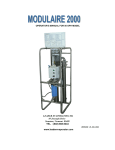

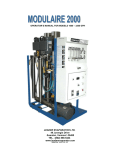

![Descargar - [ [ [ ANSEL ] ] ]](http://vs1.manualzilla.com/store/data/006268413_1-12223cddaa3301670b0a8998e4e61ac5-150x150.png)

